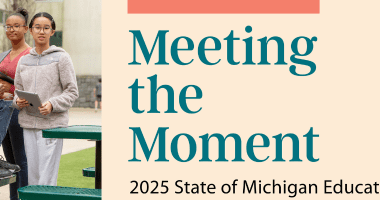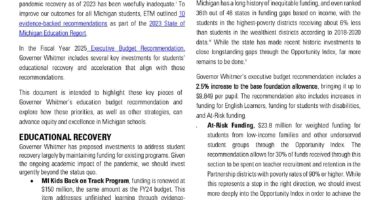New campaign aims to make Michigan top ten in education
By Kylie Khan, UPMatters
State leaders have let Michigan’s education system slump to the bottom of the national rankings and our children, and our economy, are paying the price. Michigan’s kids can’t afford to wait for action any longer. Ed Trust-Midwest’s 2015 annual report, Michigan Achieves: Becoming a Top Ten Education State, offers a bold plan for success that’s backed by years of research and data analysis.
This report offers even more proof that now is the time to make fundamental changes in the way our education system is run. Michigan’s fourth-graders are reading at lower levels than they were a decade ago. If we stay on our current path, Michigan will be 44th in the country in fourth-grade reading before 2030, playing catch up with chronically underperforming states like Arkansas.
The problem transcends geography, income and race. Michigan’s white students are on track to perform 49th out of 50 in fourth-grade reading by 2019, ahead of only West Virginia. Our African American students are among the lowest performing black students in America. Our Latino students are also seeing significant drops in student learning ranks compared to the rest of the country.
What’s more, if the state stays on its current path of educational decline, Michigan will be ranked in the bottom ten states for student learning by 2030, according to ETM’s new analysis.
Our children, and our state, deserve better than this.
“Michigan has a clear choice: if the state continues to maintain its educational status quo, it will become among the lowest achieving in the United States for public education. We will doom our children and state to become increasingly poor, isolated, and deprived of opportunities,” says Amber Arellano, executive director of the nonpartisan Education Trust-Midwest, an education research, policy, and technical assistance nonprofit organization.
“Or, we can choose a new path,” Arellano added. “It means getting focused on what’s been proven to work in other states to become a top improvement state within five years. Other states have done it. We can, too.”
Leading states for educational improvement, such as Tennessee, Florida, and Massachusetts, have proven that targeted, smart investments can have a huge impact on education outcomes.
The prospect of rising up from the bottom of the educational rankings to the top may be daunting but Michigan Achieves provides a clear roadmap for success. This report measures Michigan’s educational performance and progress from kindergarten through post-secondary education, offers specific policy recommendations and key investment areas that are backed by research, and provides the metrics to measure progress.
The new plan recommends clear steps for Michigan to take by 2016 and 2020 to dramatically raise learning for all students, targeting investment in four key areas that are proven to show results: teaching quality, higher standards, school accountability, and increased learning opportunities for all of Michigan’s students through improved funding equity.
The need is clear. Some findings from our 2015 annual report are:
- Michigan ranks near the bottom in college affordability for all students and 45th out of 47 for low-income students. For families in the bottom 20 percent of income in Michigan, the cost of four-year college for one child, after receiving financial aid, is about 77 percent of their annual income.
- Michigan is also in the bottom ten states in terms of funding equity, meaning the state has some of the biggest gaps in resources between high-poverty districts and those in more well off communities. Similar gaps also exist for teachers in high-poverty schools, who have some of the most important jobs in America.
- Michigan has the third-highest rate of out-of-school suspensions for African Americans in the U.S. From 2011-2012, more than one out of five black students were suspended.
- Since 2003, Michigan’s white students have fallen from 13th to 45th in fourth-grade reading achievement compared to the rest of the country. If the state stays on its current path, white student achievement will be 49th in fourth-grade reading by 2019, ahead of only West Virginia.
As our state and our economy begin to recover from the depths of the Great Recession, it’s imperative that we don’t leave our children behind. We can dream big because we have the tools to make our dreams a reality. Other states have proven that a turnaround is possible and now is the time to make the investment in our children, our state and our future.
It’s time that Michigan Achieves.











